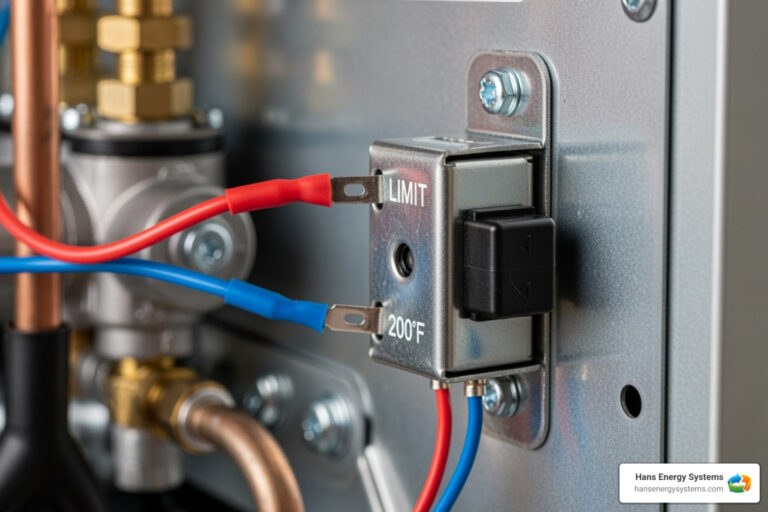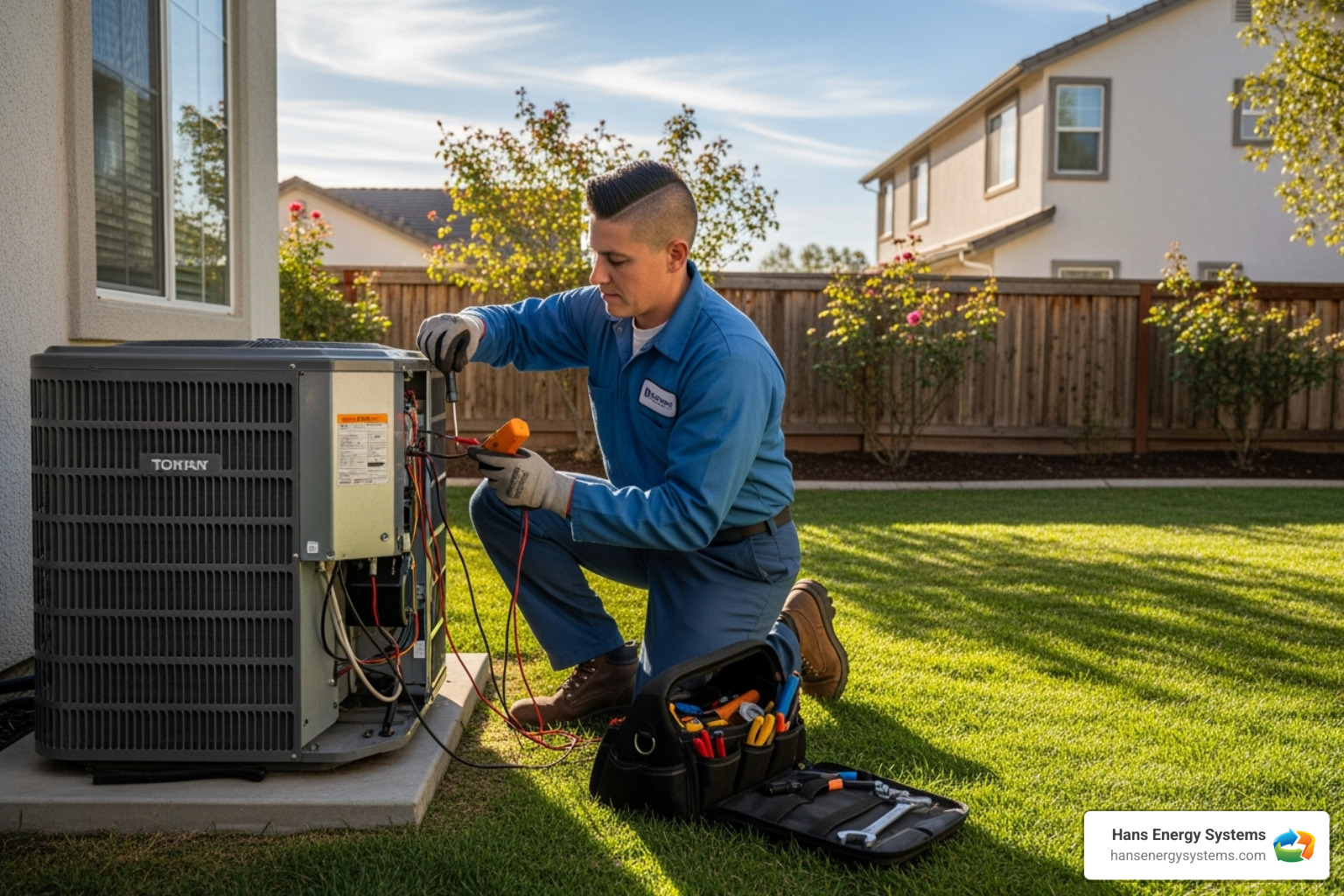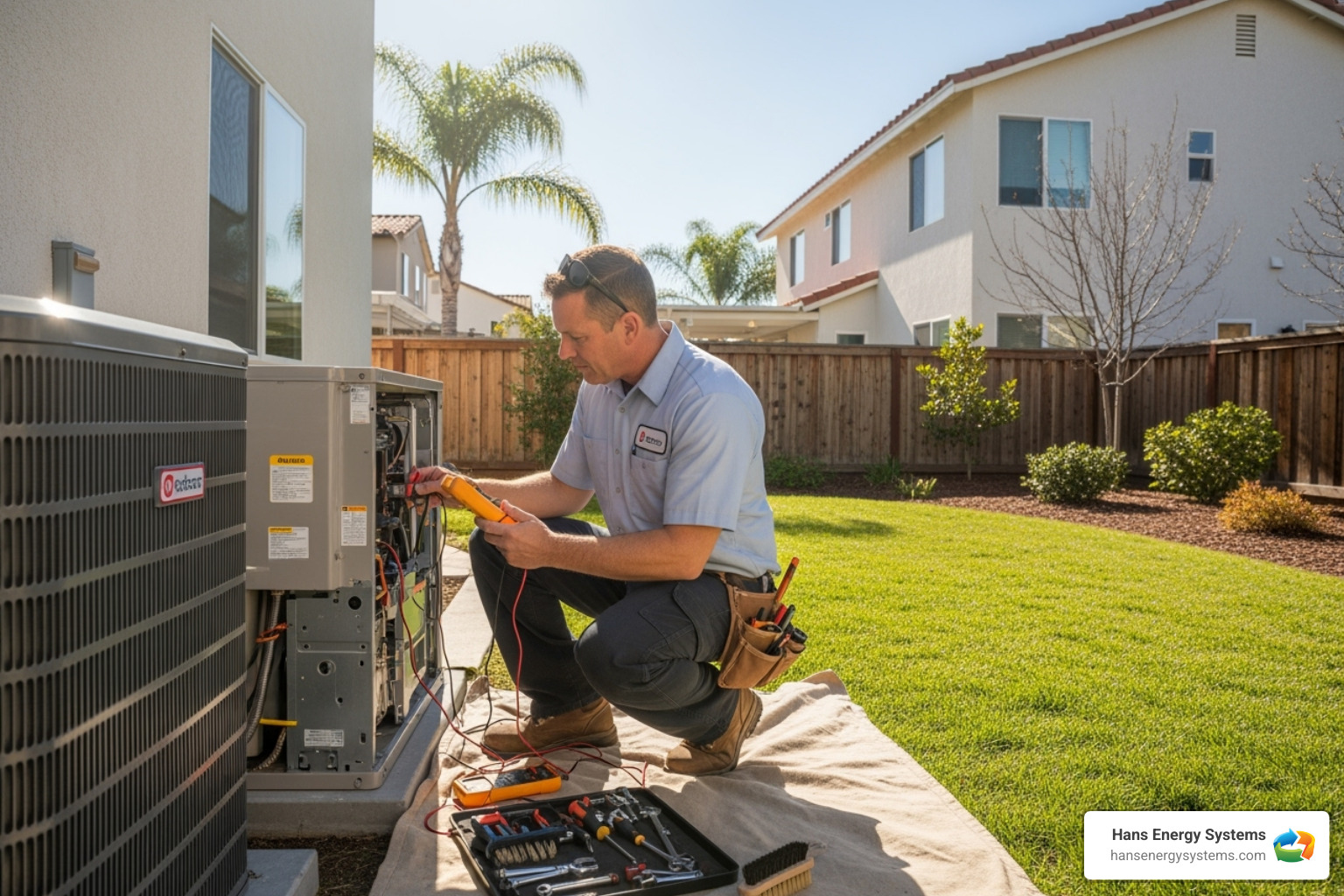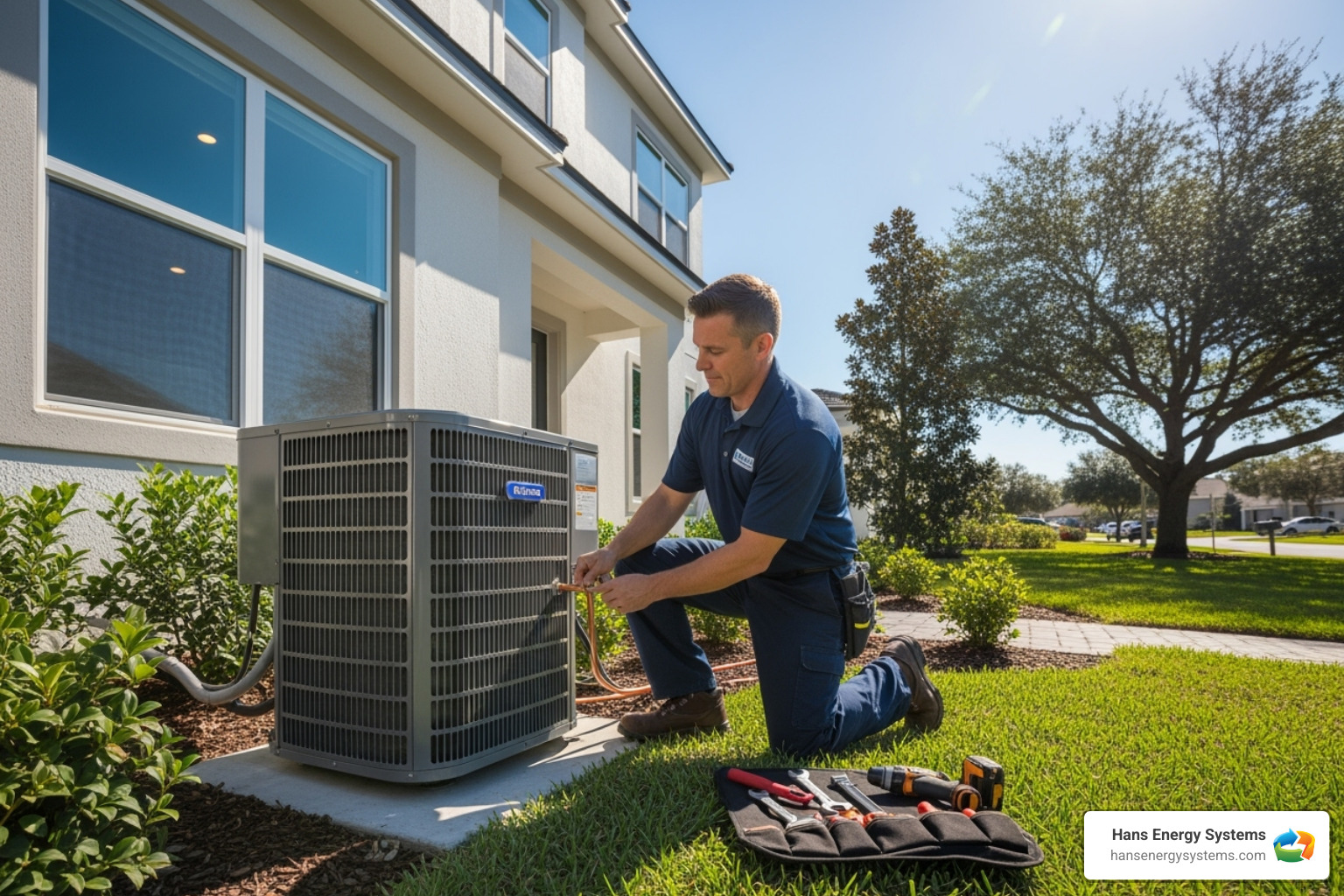Why Your Furnace’s Hidden Guardian Matters
A furnace limit switch is a critical safety component that monitors your furnace’s internal temperature and controls when the blower fan turns on and off. This small but essential device prevents dangerous overheating while ensuring your home gets warm air efficiently.
Quick Facts About Furnace Limit Switches:
- Primary Function: Monitors furnace temperature and controls blower operation
- Safety Role: Shutts down burners if internal temperature gets too high
- Location: Usually inside the furnace near the heat exchanger or plenum
- Common Issues: Dirty air filters, blocked vents, or worn components can cause problems
- Replacement Cost: Professional repair typically costs $100-$270; DIY parts under $20
There’s nothing quite like getting all cozied up to enjoy some delicious furnace-supplied warmth, only to be met with a blast of cool air. If this fickle furnace phenomenon sounds all too familiar, your culprit may be a pesky limit switch gone rogue.
Your furnace has several safety devices working behind the scenes to keep your Southern California home comfortable and safe. The limit switch acts like a smart thermostat for your furnace’s internal components – it knows exactly when to turn your blower on to circulate warm air and when to shut everything down if temperatures get dangerous.
Most homeowners never think about this component until something goes wrong. But understanding how it works can help you spot problems early and avoid costly repairs or safety hazards.
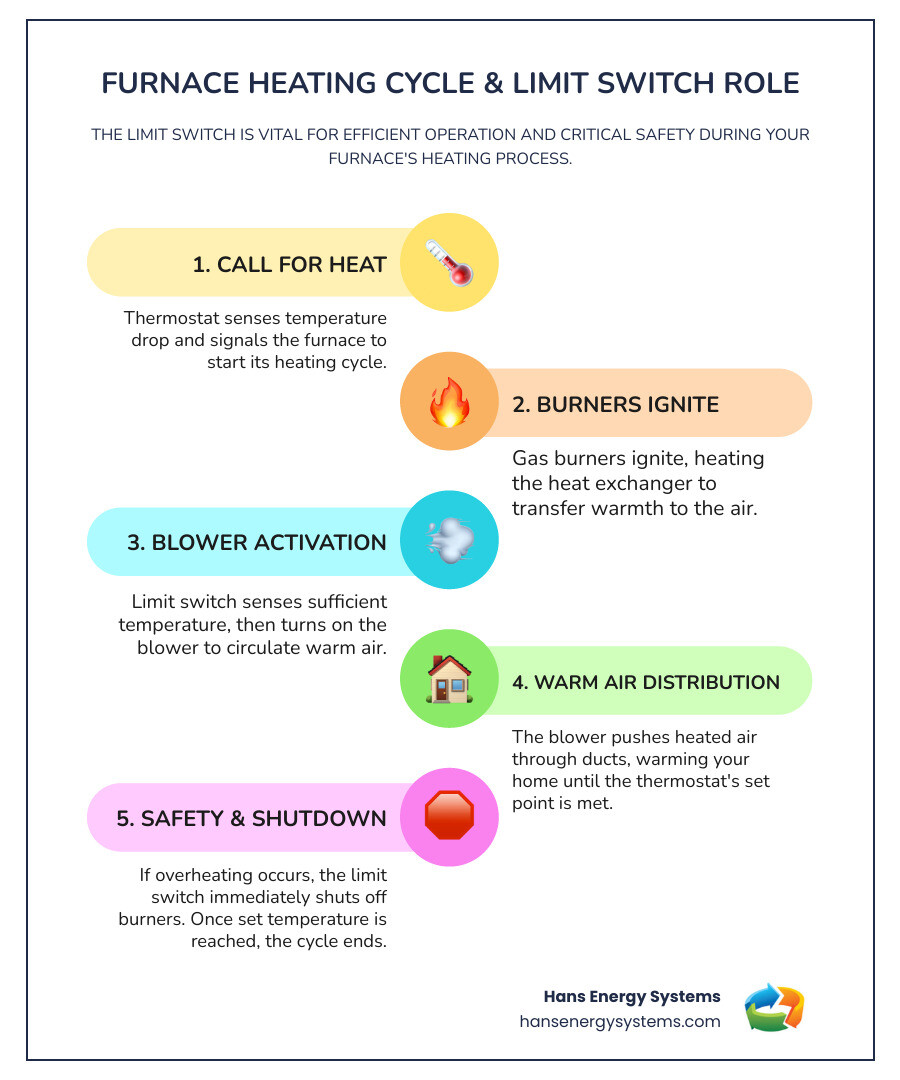
What is a Furnace Limit Switch and What Does It Do?
Picture a tiny security guard standing watch inside your furnace, constantly checking the temperature and making sure everything stays safe. That’s essentially what your furnace limit switch does! This small but mighty safety device sits near your furnace’s heat exchanger or plenum (the chamber where heated air collects before traveling through your ducts).
The switch itself looks pretty simple from the outside – usually just a metal plate with wires attached. But inside, there’s some clever engineering at work. Most limit switches use a bimetallic strip that bends and flexes as temperatures change, kind of like how a candy thermometer works. This strip opens and closes electrical contacts, sending signals to your furnace about what to do next.
Here’s how it works in your daily life: When you adjust your thermostat for some cozy warmth, your furnace burners fire up and start heating the air. The furnace limit switch keeps a close eye on this temperature. Once the air gets nice and toasty (usually around 120°F to 150°F), the switch gives your blower motor the green light to start pushing that warm air through your home.
This timing is crucial – nobody wants a blast of cold air when their heat first kicks on! The limit switch makes sure you only get the good stuff.
If you’re dealing with heating issues, our comprehensive guide on common heating problems and solutions can help you troubleshoot what’s going on.
The Limit Switch’s Dual Role: Efficiency and Safety
Your furnace limit switch is like that friend who’s both practical and protective – it keeps your system running smoothly while watching out for danger.
On the efficiency side, this little device is all about perfect timing. It makes sure your blower only kicks in when the air is actually warm enough to heat your home. No more chilly surprises from your vents! Even better, it keeps the fan running for a bit after the burners shut off, squeezing every bit of warmth out of the heated air before calling it quits. This smart coordination can really help keep your energy bills in check.
But here’s where the limit switch really earns its keep: safety. If something goes wrong and your furnace starts getting too hot (usually around 180°F to 200°F), this device immediately cuts power to the burners. Think of it as hitting the emergency brakes.
Why is this so important? An overheated furnace can crack the heat exchanger, which isn’t just expensive to fix – it can leak dangerous carbon monoxide into your home. The limit switch prevents these scary scenarios by shutting things down before damage occurs. It’s literally protecting your family from fire hazards and poisonous gas exposure.
A properly functioning limit switch is essential for keeping your heating system operating efficiently and safely.
Furnace Limit Switch vs. Pressure Switch
Both switches are safety heroes in your furnace, but they’re watching for completely different problems. Think of them as specialized security guards with different jobs.
| Feature | Furnace Limit Switch | Furnace Pressure Switch |
|---|---|---|
| Primary Function | Monitors internal furnace temperature | Monitors air pressure/airflow in the venting system |
| What it Detects | Overheating (excessive heat) | Negative pressure (proper venting/combustion airflow) |
| Safety Role | Prevents overheating, protects heat exchanger, controls blower | Ensures safe combustion by verifying exhaust flow |
| Action when Tripped | Shuts off burners; blower continues to cool furnace | Shuts down furnace (often before ignition) |
| Typical Location | Near the heat exchanger/plenum | Inside the motor compartment, near the inducer motor |
| Causes of Trip | Dirty filter, blocked vents, blower motor issues, oversized furnace | Blocked flue, faulty inducer motor, clogged drain, cracked heat exchanger |
Your furnace limit switch is all about temperature – making sure things don’t get too hot inside the furnace itself. Meanwhile, the pressure switch focuses on airflow detection, ensuring that dangerous combustion gases are properly vented outside your home.
When the pressure switch senses something’s wrong with the exhaust system (like a blocked flue), it won’t even let your furnace try to light up. It’s preventing toxic gases from building up in your house before they even have a chance to form.
Both switches are absolutely essential, but they’re protecting you from different dangers. The limit switch prevents internal overheating and damage, while the pressure switch ensures safe venting of combustion gases.
Troubleshooting a Malfunctioning Furnace Limit Switch
Even the most robust components can encounter problems, and your furnace limit switch is no exception. When it starts to malfunction, your furnace might exhibit some frustrating behaviors like short cycling (turning on and off frequently), the blower running continuously, or even refusing to turn on at all. These issues often stem from underlying problems that cause the switch to trip as a safety measure.
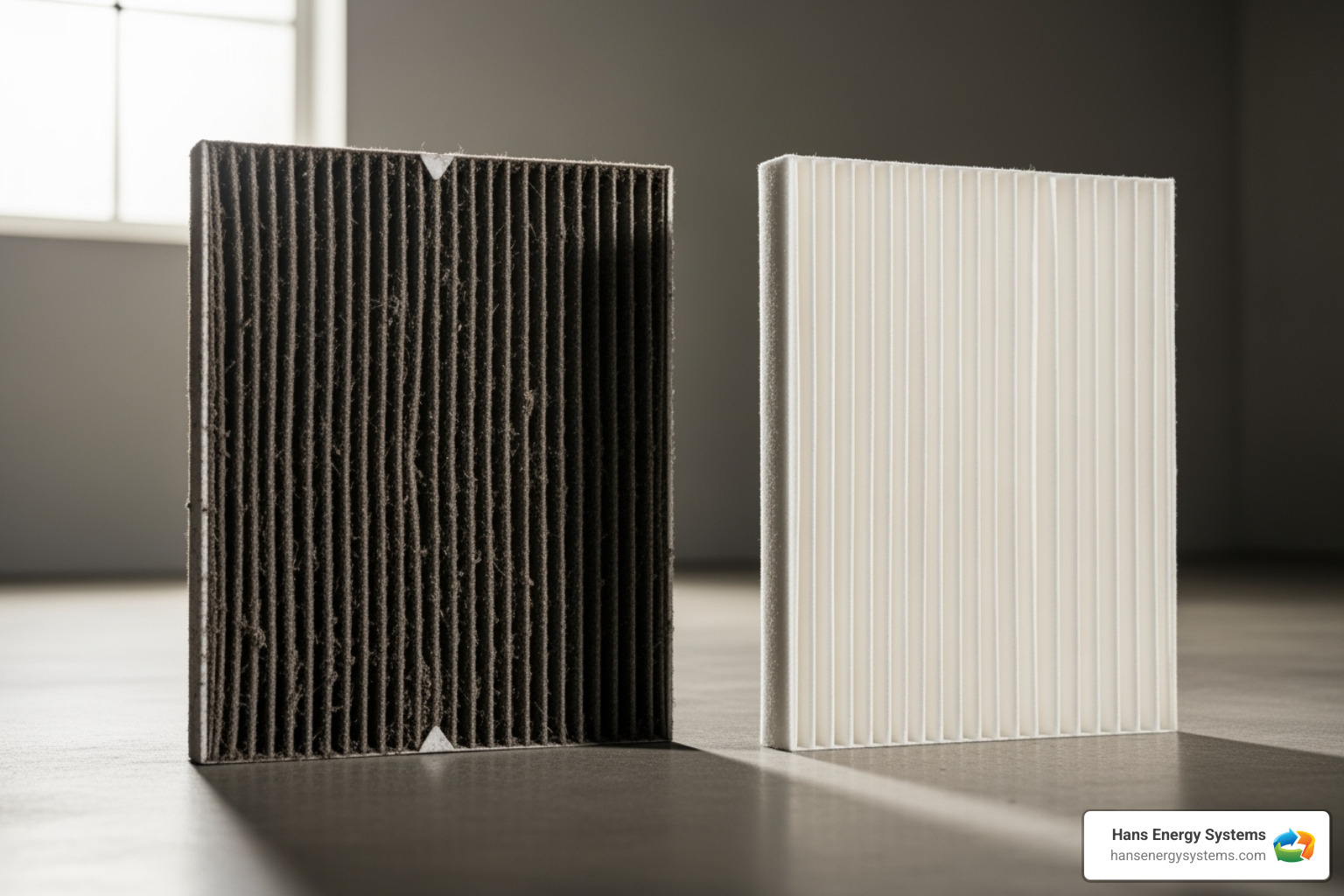
One of the most common culprits, as we’ll explore, is restricted airflow – often due to a dirty, clogged furnace air filter like the one you see on the left! It’s surprising how such a small thing can cause a chain reaction leading to a tripping limit switch.
When your furnace is acting up, understand the potential role of the limit switch. For more detailed information on common signs that your heating system needs professional attention, check out our guide on Signs You Need Heating Repair in Poway.
Common Signs of a Bad Furnace Limit Switch
Recognizing the symptoms of a failing furnace limit switch can help you address the problem before it escalates. Here are the most common warning signs:
- The blower fan runs constantly, even when the furnace isn’t heating. This is a classic sign. If the limit switch is stuck in the “on” position, or if it’s not correctly sensing the temperature drop after the burners shut off, the blower will just keep running, often blowing cool air.
- The furnace won’t turn on or fails to ignite. If the limit switch has failed in the “open” position, it won’t allow the furnace to start its heating cycle because it thinks the furnace is already too hot or unsafe to operate.
- The furnace shuts off prematurely or “short cycles.” This happens when the furnace heats up too quickly, triggering the limit switch to shut off the burners before your home reaches the desired temperature. The furnace might then try to restart shortly after, leading to a frustrating on-and-off cycle.
- Cool air comes from the vents instead of warm air. This can occur if the furnace ignites and then quickly trips the limit switch, shutting off the burners but leaving the blower running. You’ll feel air, but it won’t be warm.
- The furnace overheats. While the limit switch is designed to prevent this, a severely malfunctioning switch might fail to cut off the burners, leading to dangerous overheating. If you notice a burning smell or excessive heat from your furnace, turn it off immediately.
Top Causes of a Tripping or Failing Switch
When your furnace limit switch keeps tripping, it’s usually a symptom of another problem, not the problem itself. Here are the most frequent causes we encounter:
- Dirty or Clogged Air Filters: This is arguably the number one culprit. An air filter is like your furnace’s lungs. When it’s clogged with dust and debris, it restricts airflow over the heat exchanger. This causes the heat exchanger to overheat rapidly, triggering the limit switch to shut off the burners as a safety precaution. Spending $10 for a new filter is totally worth it if you want to prevent bigger repair costs down the road! Furnace manufacturers recommend changing air filters every 1-3 months.
- Restricted Airflow (Blocked Vents or Registers): Just like a dirty filter, blocked vents or registers prevent heated air from circulating properly. Furniture, rugs, or even dust accumulation can block airflow, causing heat to build up inside the furnace and trip the limit switch. Ensure all your vents are open and clear.
- Malfunctioning Blower Motor: The blower motor is responsible for moving air across the heat exchanger and through your ductwork. If it’s malfunctioning, running at reduced capacity, or has dirty blades, it won’t move enough air. This leads to heat buildup and an inevitable limit switch trip. Signs of a bad blower motor include reduced airflow, inconsistent heating, frequent cycling, or unusual noises.
- Wear and Tear / Dirty Sensors: Over time, the furnace limit switch itself can accumulate dirt or grime on its temperature probe or internal contacts. This can prevent it from accurately reading the temperature or making proper electrical connections, leading to erratic behavior or failure. Like any mechanical component, it also simply wears out with age.
- Oversized Furnace: Believe it or not, a furnace that’s too large for your home can cause the limit switch to trip. An oversized furnace heats up the space too quickly, satisfies the thermostat, and then shuts off before completing a full heating cycle. This “short cycling” can lead to rapid temperature fluctuations inside the furnace, causing the limit switch to trip due to the abrupt changes.
How to Safely Test Your Switch
If you suspect your furnace limit switch is the problem, you might be tempted to test it yourself. While we always recommend professional assistance for furnace issues, especially those involving critical safety components, here’s a basic overview of how a limit switch is typically tested for continuity.
Crucial Safety Warning: Always, always turn off all power to your furnace at the circuit breaker before attempting any inspection or testing. If your furnace is gas-fired, also turn off the gas supply. Working with high voltage electricity and gas lines can be extremely dangerous and can lead to serious injury, fire, or carbon monoxide poisoning if not handled correctly.
Here’s how a professional would approach testing the switch:
- Cut the Power and Gas: Locate your furnace’s dedicated circuit breaker in your electrical panel and flip it to the “off” position. For gas furnaces, also turn the gas valve to the “off” position.
- Locate the Switch: The furnace limit switch is usually found inside the furnace’s main access panel, often near the heat exchanger or blower compartment. It might look like a small rectangular box with a temperature probe extending from it.
- Disconnect Wires: Carefully disconnect the wires leading to the limit switch. It’s a good idea to take a picture before disconnecting so you remember where they go.
- Use a Multimeter: Set your multimeter to the “continuity” or “ohms” setting.
- Test for Continuity: Place one probe of the multimeter on each terminal of the limit switch.
- Normally Closed: Most furnace limit switches are “normally closed,” meaning they should show continuity (a reading of 0.00 ohms or a beep) when at room temperature. If it shows no continuity (an open circuit or “OL”), the switch is bad and needs replacement.
- “Fail Open” Design: High limit switches are designed to “fail open.” This means if they go bad, or if the temperature gets too high, they open the circuit to prevent the furnace from operating, prioritizing safety.
- Reassemble: If the switch tests good, reconnect the wires, replace the access panel, and restore power and gas. If it tests bad, replace it with an exact duplicate part.
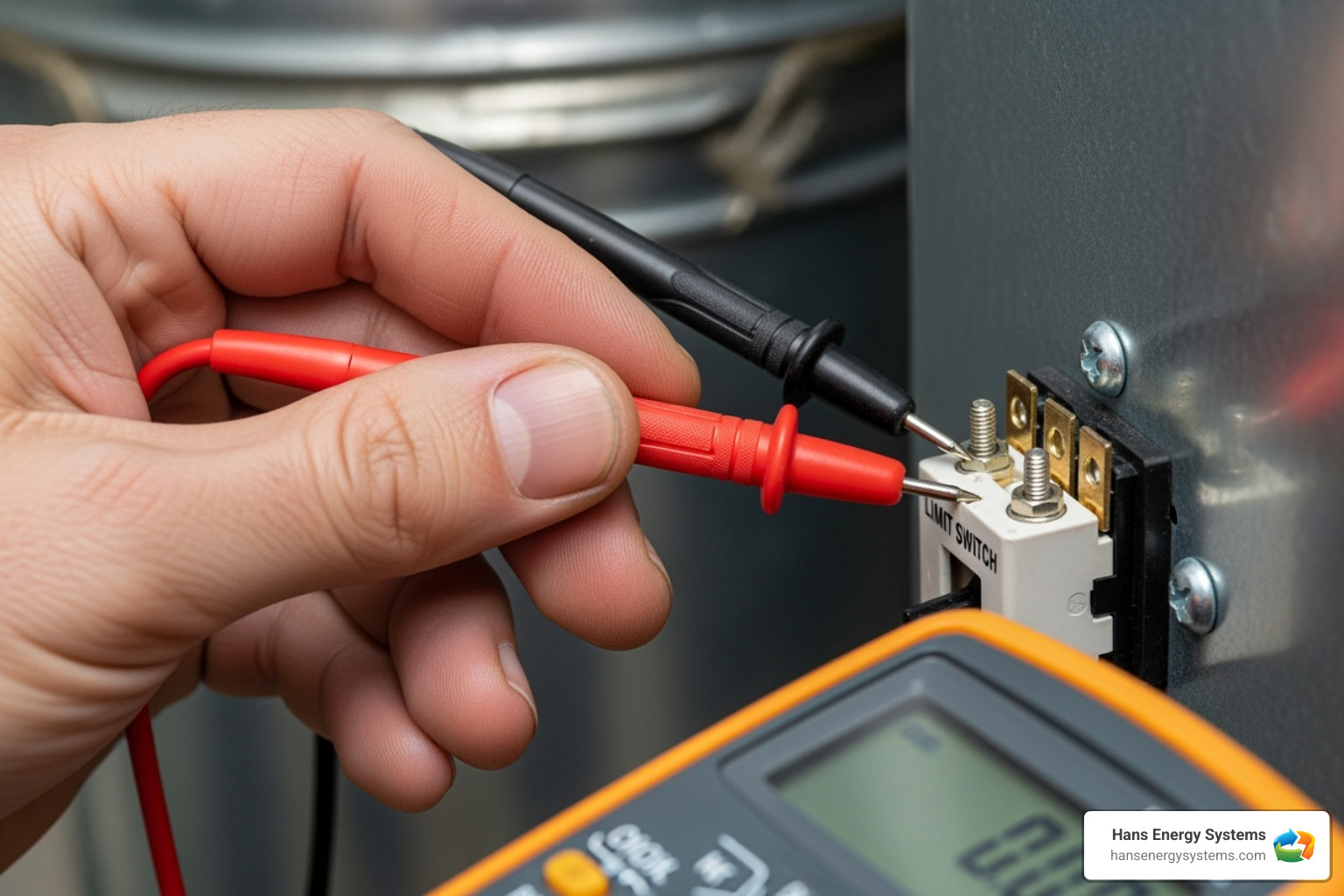
If the limit switch tests OK or has been replaced and the issue persists, the thermostat might be the next component to investigate. For a more detailed guide on testing, you can refer to resources like How to test the furnace limit switch.
DIY vs. Professional Repair: Costs, Risks, and When to Call for Help
When your furnace limit switch starts acting up, it’s natural to wonder if you can tackle the repair yourself. After all, the part itself costs under $20, while professional service runs $100-$270. That’s quite a difference! But before you grab your toolbox, let’s talk about what’s really at stake here.
Your furnace isn’t just another household appliance – it’s a complex system that combines high voltage electricity with combustible fuel (in gas furnaces). One small mistake can lead to carbon monoxide leaks, fire hazards, or serious injury. We’ve seen well-meaning DIY attempts turn into emergency service calls that cost far more than the original repair would have.
That said, we totally understand the appeal of fixing things yourself. There’s something satisfying about solving a problem with your own two hands! The key is knowing when a project is within your skill level and when it’s time to call in the pros.
For comprehensive maintenance that keeps these issues from happening in the first place, check out our HVAC Maintenance in Poway, CA services.
Can I Replace a Furnace Limit Switch Myself?
Technically speaking, yes – replacing a furnace limit switch is possible for a handy homeowner. The basic steps seem straightforward enough: shut off power and gas, locate the old switch, disconnect the wires, swap in the new part, and reconnect everything.
But here’s where things get tricky. You’ll need the right tool requirements including a multimeter, basic hand tools, and sometimes specialized equipment. More importantly, part sourcing can be a real headache – you must find the exact match for your furnace model, including the correct voltage ratings and temperature range. Using the wrong switch can create serious safety issues.
The electrical wiring aspect is where many DIYers run into trouble. Furnaces use high voltage components that can deliver a dangerous shock if handled incorrectly. Gas furnaces add another layer of complexity with fuel lines that require careful attention to prevent leaks.
But here’s the biggest challenge: a failing limit switch is usually a symptom, not the root problem. Maybe your air filter is clogged, your blower motor is struggling, or your ductwork is blocked. Simply swapping the switch without addressing these underlying issues means you’ll likely be right back where you started in a few weeks.
Furnace model compatibility is another hurdle. What looks like the same part might have different temperature settings or reset mechanisms that aren’t right for your specific system.
Understanding Repair and Replacement Costs
Let’s break down the real costs so you can make an informed decision about your furnace limit switch repair.
If you go the DIY route, you’re looking at under $20 for the part itself. Sounds great, right? But that’s just the beginning. You might need tools you don’t have, and if something goes wrong, you could be facing much bigger repair bills.
Professional repair costs typically range from $100 to $270 on average. Yes, it’s more upfront, but here’s what you’re actually paying for:
Diagnostic fees cover the technician’s time to properly identify the problem. They’ll figure out not just that your limit switch is bad, but why it failed. Maybe it’s a dirty filter causing overheating, or a blower motor that’s not moving enough air.
Labor costs reflect the expertise of someone who works on furnaces every day. They know exactly which part you need, how to install it safely, and how to test the system afterward. They also carry insurance in case something goes wrong.
The real value comes from addressing the root cause. A professional won’t just slap in a new switch and call it done. They’ll check your air filter, inspect your blower motor, and make sure your system is running efficiently. This comprehensive approach often prevents the same problem from happening again.
When you factor in the safety risks, the time you’ll spend troubleshooting, and the possibility of having to call a professional anyway if things go wrong, that $100-$270 investment starts looking pretty reasonable. Plus, you’ll have peace of mind knowing the job was done right the first time.
Frequently Asked Questions about Furnace Limit Switches
When it comes to furnace limit switches, we hear the same concerns from San Diego homeowners time and time again. These questions usually come up right when someone’s furnace starts acting up – and they’re scrambling to figure out what’s going on. Let’s tackle the most common ones with straightforward answers that’ll help you understand this crucial component better.
What happens if a furnace limit switch is bypassed?
This is probably the most dangerous question we get, and the answer is simple: never, ever bypass a furnace limit switch. Some homeowners think they can “fix” their furnace problems by jumping around the safety controls, but this removes your furnace’s primary protection against overheating.
Without a functioning furnace limit switch, your furnace can overheat to dangerous levels. This can crack your heat exchanger – an expensive repair that often costs more than replacing the entire furnace. Even worse, a cracked heat exchanger can leak deadly carbon monoxide gas into your home, putting your family at serious risk.
Bypassing the limit switch also creates fire hazards and can cause extensive damage to other furnace components. Insurance companies may even refuse to cover damages caused by bypassed safety devices. The few dollars you might save by avoiding professional repair simply isn’t worth risking your family’s safety.
How often should a furnace limit switch be replaced?
Here’s some good news: a furnace limit switch doesn’t need regular replacement like your air filter does. Unlike other furnace components that wear out on a predictable schedule, limit switches only need replacing when they actually fail.
With proper furnace maintenance, a limit switch can last for the entire lifespan of your furnace – often 15 to 20 years. The key phrase here is “proper maintenance.” Regular tune-ups, clean air filters, and addressing airflow issues early can help your limit switch last decades.
The switch should only be replaced when it fails a continuity test or a professional technician confirms it’s faulty. If your furnace is cycling on and off frequently, the blower runs constantly, or you’re getting cool air from your vents, it’s worth having the switch checked regardless of its age.
Can a dirty air filter really cause the limit switch to trip?
Absolutely! This might surprise you, but a dirty, clogged air filter is actually one of the most common reasons we see furnace limit switches tripping. It seems almost too simple, but it’s true.
When your air filter gets packed with dust, pet hair, and debris, it creates a bottleneck that severely restricts airflow over the heat exchanger. Think of it like putting your hand over a hair dryer – the heat has nowhere to go and builds up quickly.
Your limit switch detects this dangerous temperature spike and immediately shuts down the burners to protect your furnace. The switch is just doing its job, but the real problem is that dirty filter choking off the airflow.
This is exactly why regular furnace maintenance is so important. Changing your air filter every 1-3 months is one of the simplest things you can do to prevent limit switch problems and keep your furnace running safely and efficiently. A $10 filter can save you hundreds in repair costs!
Conclusion: Keep Your San Diego Home Safe and Warm
Your furnace limit switch might be tucked away out of sight, but it’s working around the clock as your heating system’s most dedicated protector. This humble little component stands guard between your family and potential dangers like overheating, fires, and carbon monoxide leaks – while also making sure you get that perfect blast of warm air when you need it most.
Think of it as having a reliable friend who never sleeps, always watching out for your safety and comfort. When everything’s working properly, you’ll never even know it’s there. But when problems arise, understanding how this vital component works can save you from costly repairs and keep your family safe.
The key to a long-lasting furnace limit switch is surprisingly simple: regular maintenance. Changing your air filter every 1-3 months might seem like a small thing, but it’s one of the most important steps you can take. A clean filter means proper airflow, which means your limit switch won’t have to work overtime trying to protect an overheating system.
Annual professional inspections are equally important, especially here in San Diego where your furnace might sit idle for months at a time. When those unexpectedly chilly nights roll around (and they always do!), you want to know your heating system will fire up reliably and safely.
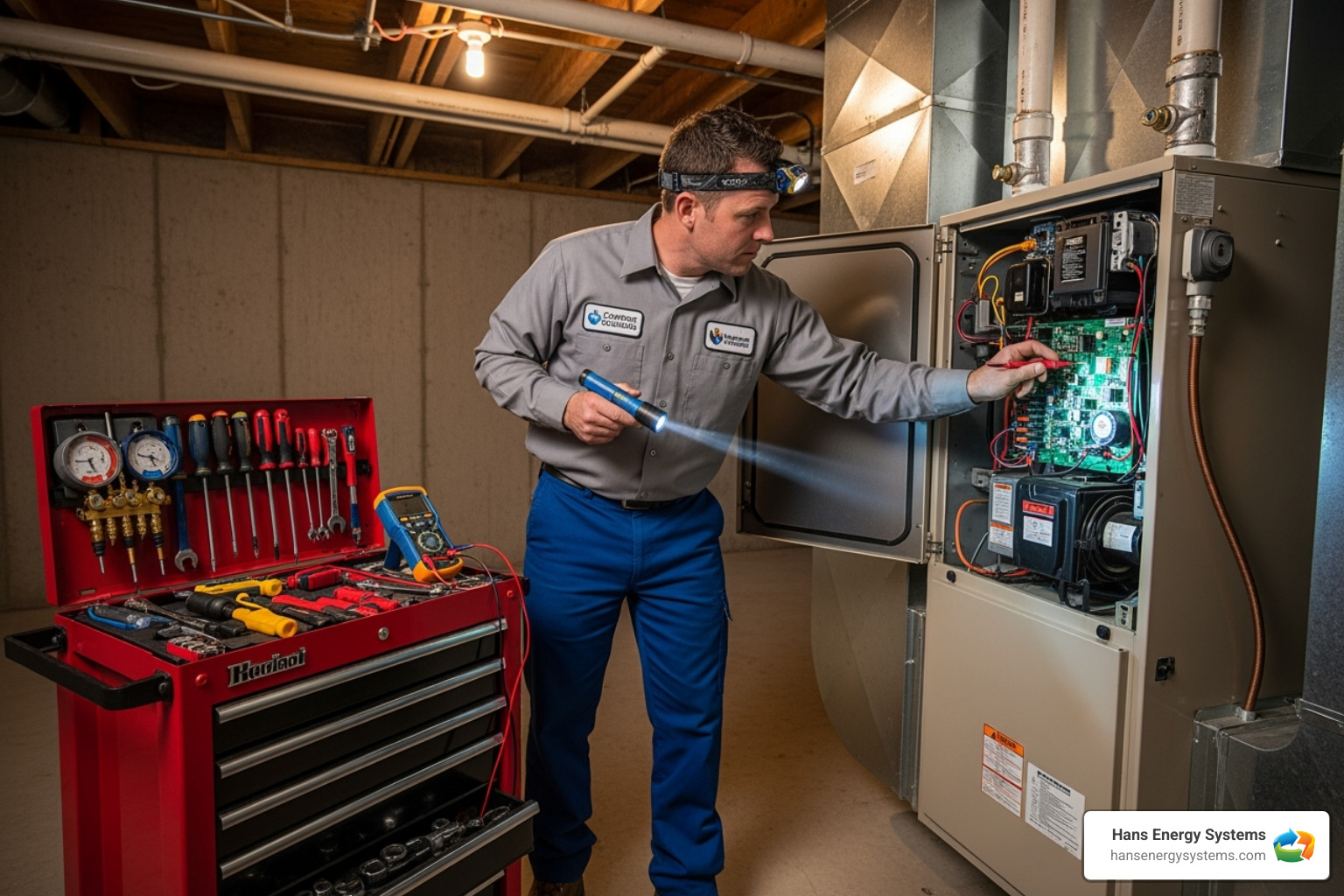
At Hans Energy Systems, we understand that your home’s comfort and safety aren’t things you should have to worry about. Our team brings exceptional customer service, competitive pricing, and reliable, professional work to every job across San Diego County. We’ve seen it all when it comes to furnace issues, and we know exactly how to diagnose problems quickly and fix them right the first time.
When your furnace starts acting up – whether it’s short cycling, blowing cold air, or just not turning on – don’t let the problem get worse. For expert diagnostics and safe repairs, trust the professionals to handle your Furnace Repair in Poway, CA. We’re here to keep your home warm, safe, and comfortable all season long, so you can focus on what matters most to you.


